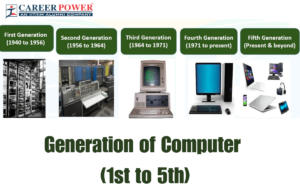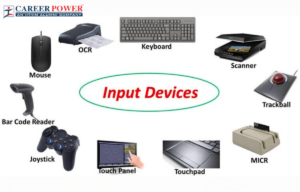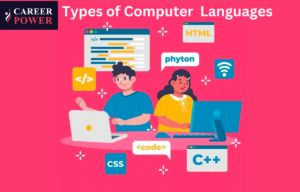What is a Computer?
In the modern world, computers have become an integral part of our daily lives, revolutionizing the way we work, communicate, and entertain ourselves. From desktops to laptops, tablets to smartphones, computers come in various forms, yet many people are still unfamiliar with their inner workings and potential. In this article, we will discuss everything about the Computer Definition, Characteristics, Components, Functionality, and Classification.
Definition of Computer
A computer is an electronic device wherein we need to input raw data to be processed with a set of programs to produce a desirable output. Computers have the ability to store, process, and manipulate data. The term “computer” is derived from the Latin word “computare,” which means “to calculate.” A computer is made to run programs and apps by using both hardware and software. It also has a memory to store data, programs, and what they produce. The Full Form of Computer is “Common Operating Machine Purposely Used for Technological and Educational Research.”
10 Different Definitions of a Computer
- Electronic device: A computer in generally termed as an electronic device that transmits data using electronic facilities and software programs
- Data processor: The computer processes data using arithmetic, logical and input/output operations
- Information machine: By processing multiple algorithms and computations, a computer gets up a meaningful definition to what we have searched
- Digital device: A computer manipulates, stores, and retrieves data represented in binary form to present it can understanding manner for humans
- Universal machine: A computer is also known as a universal machine as it can solve problems of people by understanding their program and not by any other factor
- Communication tool: Computer is a universal communication tool as it provides the facility to connect, collaborate or transfer of messages through a network and the internet
- Problem solver: Computers are designed to solve problems that can affect or slow down daily human tasks, therefore, it is a problem solver
- Multifunctional device: Multifunctionality is the power of a computer as it can perform more than 1 task at a time and that too with utmost perfection
- Information processor: Computers are fitted with processors that process raw data into organized and meaningful outputs
- Automation tool: Computers have the functionality to automate the repetitive tasks and enhance productive by saving time
Characteristics of Computer
Computers are now an integral part of our daily lives, from managing student records in schools to handling patient records in hospitals. They have significantly simplified our tasks. Now, we can quickly access stored data and solve complex problems in just seconds. Some of the characteristics of Computers are listed below-
- Saves Time: A computer saves time by completing tasks quicker and more efficiently. For example, it can solve big complex problems within seconds which can save many minutes of ours.
- Internet: Computers connect us to the internet which can help us to know important information from around the world, it can connect us with people from around the world through social networking sites, etc.
- Storage: The computer gives us enough storage space that can be used to store a large amount of data including your projects, ebooks, documents, movies, pictures, songs, etc.
- Entertainment: Computers are also a big source of entertainment as you can play games, listen to songs, watch movies, and can also use social networking sites.
- Organized Data: It not only stores the data for you for also organizes the data for you. You can create different folders for different types of data and can easily access them when required.
- Helps the physically challenged: Computers are a big boon for the physically challenged people as Stephen Hawking, who was not able to speak used the computer to speak. It also can be used to help blind people by installing special software to read what is on the screen.
Features OF Computer
We have discussed a few points that will highlight the different features of computers. These features collectively contribute to the versatility and functionality of computers.
- Processing Power: Computers can execute instructions and perform calculations quickly.
- Storage Capacity: They can store vast amounts of data, from documents to multimedia files.
- Memory (RAM): Temporary storage used for actively running programs and processes.
- Input Devices: Keyboards, mouse, and other peripherals allow users to input data.
- Output Data: Monitors, printers, and speakers display or produce results.
- Upgradability: Components like RAM, storage, and graphics cards can be upgraded.
- Portability: Laptops and tablets offer mobility compared to desktop computers.
- User Interface: Graphical user interfaces (GUIs) or command-line interfaces for interaction.
- Security Features: Passwords, firewalls, and antivirus tools protect against unauthorized access.
- Power Management: Features to optimize energy consumption.
History of Computer
To understand the development of computers, and how they evolved from simple mechanical devices to the complex electronic machines that we use today. The knowledge can help to appreciate the challenges that computer scientists have faced over the years and the ingenuity they have shown in overcoming them.
Studying the history of computers can help to anticipate future developments in the field. The history of computers can be traced back to the ancient Greeks, who used the abacus to perform simple calculations. In the 17th century, Blaise Pascal invented the mechanical calculator, which could perform more complex calculations. In the 19th century, Charles Babbage designed the Analytical Engine, which is considered to be the first general-purpose computer. By understanding the history of computers that have shaped the development in the past.
Classification of Computers
Computers come in various types, primarily categorized by their data handling capacity and physical size. Based on the size, computers are 5 types namely, Micro Computer, Mini Computer, Mainframe Computer, Super Computer and Work stations. Whereas, based on data handling capacity, there are 3 types of computers namely analogue computers, digital computers, and hybrid computers. All the different types of computers perform different tasks and have been designed differently. For your reference, we have discussed all the types of computers and you can scroll through the page to read them all.
Based on Size
There are various types of computers available in the markets which are of different sizes. These computers are different from each other with respect to the amount of work they can do or the amount of data they can hold. Here we have classified the main 5 types of computers based on their size and have also provided the details regarding the same.
| Different Types of Computers Based on Its Size | |
| Types of Computer | Description |
| Micro Computers | Microcomputers are small, affordable computers for personal use. Examples include desktops and laptops. They handle everyday tasks like browsing, word processing, and entertainment. |
| Mini-computers | Minicomputers are mid-sized computers, more powerful than personal computers but smaller than mainframes. They handle complex tasks for businesses and institutions, offering moderate processing capabilities. |
| Mainframe Computers | Mainframe computers are powerful computers used by large organizations for critical applications and data processing. |
| Super Computer | Supercomputers are high-performance machines used for complex calculations, simulations, and scientific research. |
| Work stations | Workstations are advanced computers used for graphics, engineering, and scientific applications. |
1. Micro Computer:
Micro Computers are mainly single-user computers and have comparatively lesser storage and speed than other computers. The first microcomputer was built with 8-bit microprocessor chips as these computers use microprocessors as CPU. Laptops, smartphones, desktop computers, etc. are all examples of microcomputers. These computers are made for everyday tasks like browsing the web and using programs like Microsoft Office MS Word etc..
2. Mini Computer:
Midrange computers or Mini-computers are multi-user computers designed in a way so as to entertain multiple users simultaneously. Small businesses and firms use these computers for their specific purposes. For example- a company or organization may use mini computers to look after the employee directory which may handle the payment history of its employees and any schools may use them to keep records of the students or for admission purposes.
3. Mainframe Computer:
Mainframe Computers are also not designed for single users, rather it is a multi-user computer that can handle thousands of users all at once. Large industries and government organizations utilize these computers to facilitate their business operations by storing substantial volumes of data. Banks and insurance companies use these computers to store the data of their customers, their policies, etc.
4. Super Computer:
Super Computer is the fastest type of computer amongst all and is also the most expensive. They can store a large number of data and can perform the most complex tasks within seconds. They can also execute millions of instructions per second. These computers are designed specifically to handle specific tasks such as weather forecasting, space research, and more. Supercomputers are also used by NASA for their Satellite launching.
5. Work Stations:
Workstations are single-user computers and have more powerful microprocessors than a microcomputer. When it comes to speed and storage capacity, it comes between a personal computer and a mini-computer. The most common uses of a workstation are desktop publishing, engineering designs, etc.
Based on Data Handling Capacity
Computers can be divided into 3 types based on their data handling capacity namely, analog, digital, and hybrid computers. These are different from each other with respect to the type of work they can do and the amount of data they can handle. We have discussed these types of computers in detail below.
| Different Types of Computers Based on Data Handling Capacity | |
| Types of Computer | Description |
| Analog Computers | Analog computers use continuous physical quantities to represent data and perform calculations. They operate with signals like voltage and are distinct from digital computers. |
| Digital Computers | Digital computers process information using discrete elements (bits) represented as 0s and 1s. They perform calculations through logical operations, enabling versatile tasks and precise results. |
| Hybrid Computers | Hybrid computers combine features of both analog and digital computers. They use analog for continuous data and digital for precise calculations, offering versatility across various applications. |
Analog Computer:
The main function of Analog Computers is to process analog data. The data that changes frequently and does not have discrete values are called data and the analog computers are used at places where we have approximate values e.g., speed, temperature, pressure, etc. These computers can pick data from the devices without converting it into machine language. Some common examples of analog computers are speedometers, thermometers, etc.
Digital Computer:
Digital Computers are designed in a way so that they can perform calculations and logical operations at high speed. These computers input raw data and with the help of the programs stored in their memory, it gives the final output. Digital computers can only understand binary language i.e., 0 and 1 hence, the raw data to be given as input is converted into 0 and 1 and then it is processed. Examples are laptops, desktops, smartphones, etc.
Hybrid Computer:
Hybrid, as the name suggests is a mixture of both analog and digital computers. Hybrid computers are as fast as analog computers and also have accuracy like that of digital computers. These computers can process both continuous and discrete data as they accept analog signals and then convert them into digital signals before processing. Some common uses of Hybrid computers are in airplanes, hospitals, etc.
Components of a Computer
A computer mainly has two components i.e. hardware and software wherein the components of the computers having a physical structure such as wires, transistors, circuits, and hard disk make up the hardware whereas the programs and data make up the software. Some other important components of a Computer are discussed below.
| Different Components of a Computer | |
| Components of Computer | Description |
| CPU | The CPU (Central Processing Unit) is the brain of a computer, executing instructions and performing calculations to run software and process data for overall system functionality. |
| Computer Memory | Computer memory stores data for the computer to use. RAM (Random Access Memory) is for temporary storage, and storage devices like hard drives store data permanently. |
| Arithmetic Logic Unit | The Arithmetic Logic Unit (ALU) in a computer performs mathematical and logical operations, like addition and comparison, enabling the CPU to execute tasks and make decisions. |
| Input Devices of Computer | Common computer input devices include keyboards for trying, mice for pointing and clicking, touchscreens for direct interaction, and microphones for voice input. |
| Output Devices of Computer | Common computer output devices include monitors for displaying information, printers for producing hard copies, speakers for audio output, and projectors for larger visual displays. |
| Motherboard | The motherboard is a computer’s main circuit board, connecting and facilitating communication between components like CPU, RAM, and Peripherals. It provides the foundation for the system to foundation for the system to function. |
Central Processing Unit (CPU)
Often referred to as the “brain” of the computer, the CPU is responsible for executing instructions and performing calculations. It interprets and carries out the commands from software and hardware components.
Computer Memory
Computers have different types of memory for temporary and permanent data storage. Random Access Memory (RAM) provides fast but volatile storage, while the hard drive or Solid-State Drive (SSD) offers non-volatile, long-term storage for programs and files.
Arithmetic Logic Unit (ALU)
An arithmetic logic unit (ALU) is a key component of a computer’s central processor unit. The ALU is part of a central processing unit (CPU) and performs all arithmetic and logic operations that must be performed on instruction words. The ALU is split into two parts in some microprocessor architectures: the AU and the LU.
Input Devices of Computer
Input Devices of the Computer enable users to interact with the computer. These are tools used to provide information and commands to the computer. Examples include keyboards, mice, touchscreens, scanners, and microphones. They allow us to input commands, data, and instructions for the computer to process. Keyboards and mouse allow users to input text, navigate interfaces, and interact with software. Tochpads offer similar functions on laptops and touch-enabled devices. Microphones capture audio input, enabling voice commands, voice recordings, and communication in applications like voice chat and video conferencing.
Output Devices of Computer
Output Devices of Computers display or transmit processed information to users. These are tools that display or produce information from the computer. Common examples include monitors, printers, speakers, and headphones. They present the results of computations, provide visual feedback, or produce audio output. Monitors show visual data like tests and images, while printers create physical copies of documents. Speakers and headphones produce sound output, allowing us to hear audio from videos, music, or other multimedia on our computer.
Motherboard
The motherboard acts as the central hub connecting all the computer’s components. It houses the CPU, memory modules, expansion slots, and connectors, facilitating communication and data transfer between different parts of the system.
Functionality of a Computer
Computers possess remarkable versatility and can perform a multitude of tasks. Some basic Functionalities and uses of a Computer are discussed below.
- Data Processing: Computers excel at processing vast amounts of data quickly and accurately. They can manipulate numbers, perform complex calculations, analyze patterns, and generate reports.
- Information Storage: With their vast storage capacities, computers can store massive amounts of information, from personal files to entire databases. They enable quick retrieval and organization of data for efficient access and analysis.
- Communication: Computers facilitate seamless communication through various means, such as email, instant messaging, video conferencing, and social media. They enable global connectivity and information sharing on an unprecedented scale.
- Multimedia and Entertainment: Computers serve as multimedia powerhouses, allowing users to watch movies, listen to music, view images, play games, and edit videos. They provide immersive experiences and entertainment options for users of all ages
Finally, a computer is a remarkable electronic device that processes data, performs calculations, and executes tasks based on programmed instructions. It comprises various components working together to facilitate the input, processing, and output of information. From their ability to process data at incredible speeds to their role in communication, entertainment, and information storage, computers have revolutionized every aspect of our lives. The Computer was invented by Charles Babbage. So he is known as the father of computers.
Some Interesting Facts About Computer
Below we have discussed a few interesting Facts about computers:
- The first computer programmer was Lady Augusta Ada Lovelace, who wrote the first algorithm for Charles Babbage’s Analytical Engine in the 1840s.
- The word “Bug” in the context of computer glickes originated in 1947 when a moth caused a malfunction in the Harvard Mark II computer.
- The world’s first computer mouse was invented by Douglas Engelbart in 1964 and was made of wood.
- The term “Byte” was coined by Dr. Werner Buchholz in 1956 while working on IBM’s Stretch computer.
- The first electronic computer, ENIAC, weighed around 30 tons and used more than 17,000 vacuum tubes.
- The Apollo 11 guidance computer, which landed humans on the moon in 1969, had less processing power than a modern smartphone.



 Generation of Computers 1st, 2nd, 3rd, 4...
Generation of Computers 1st, 2nd, 3rd, 4...
 Input Devices of Computer: Definition, F...
Input Devices of Computer: Definition, F...
 Computer Languages and it's Types
Computer Languages and it's Types













